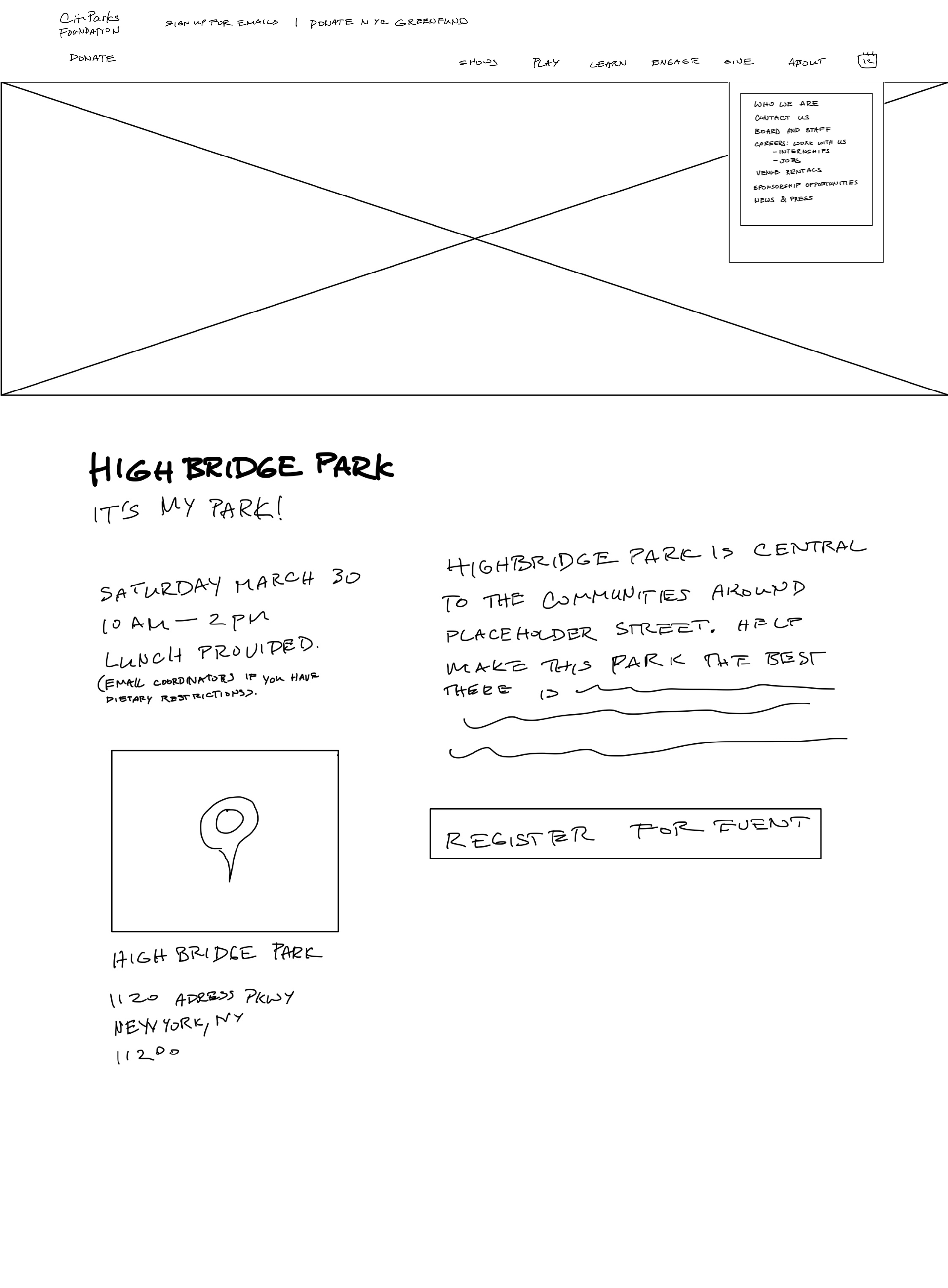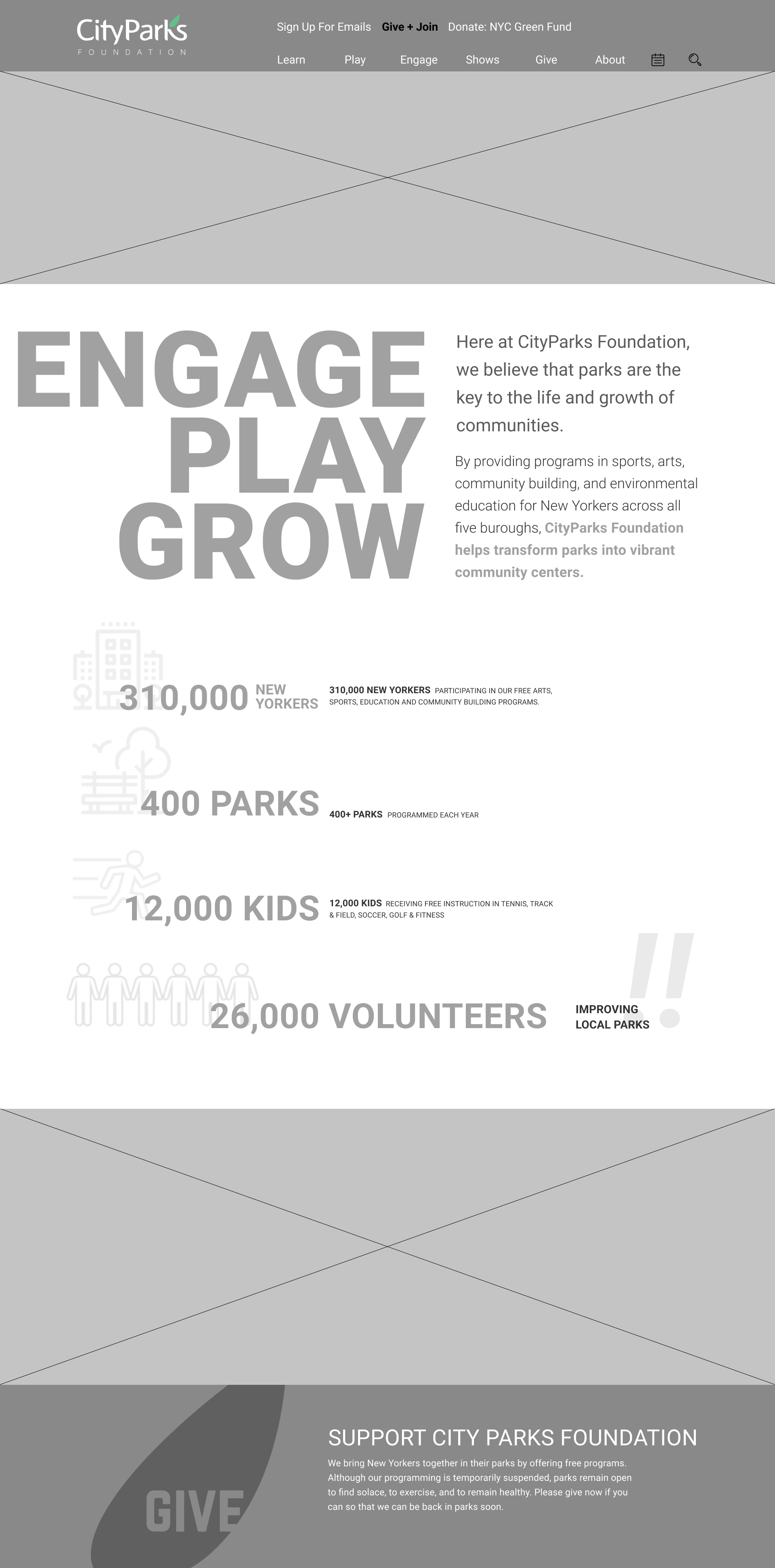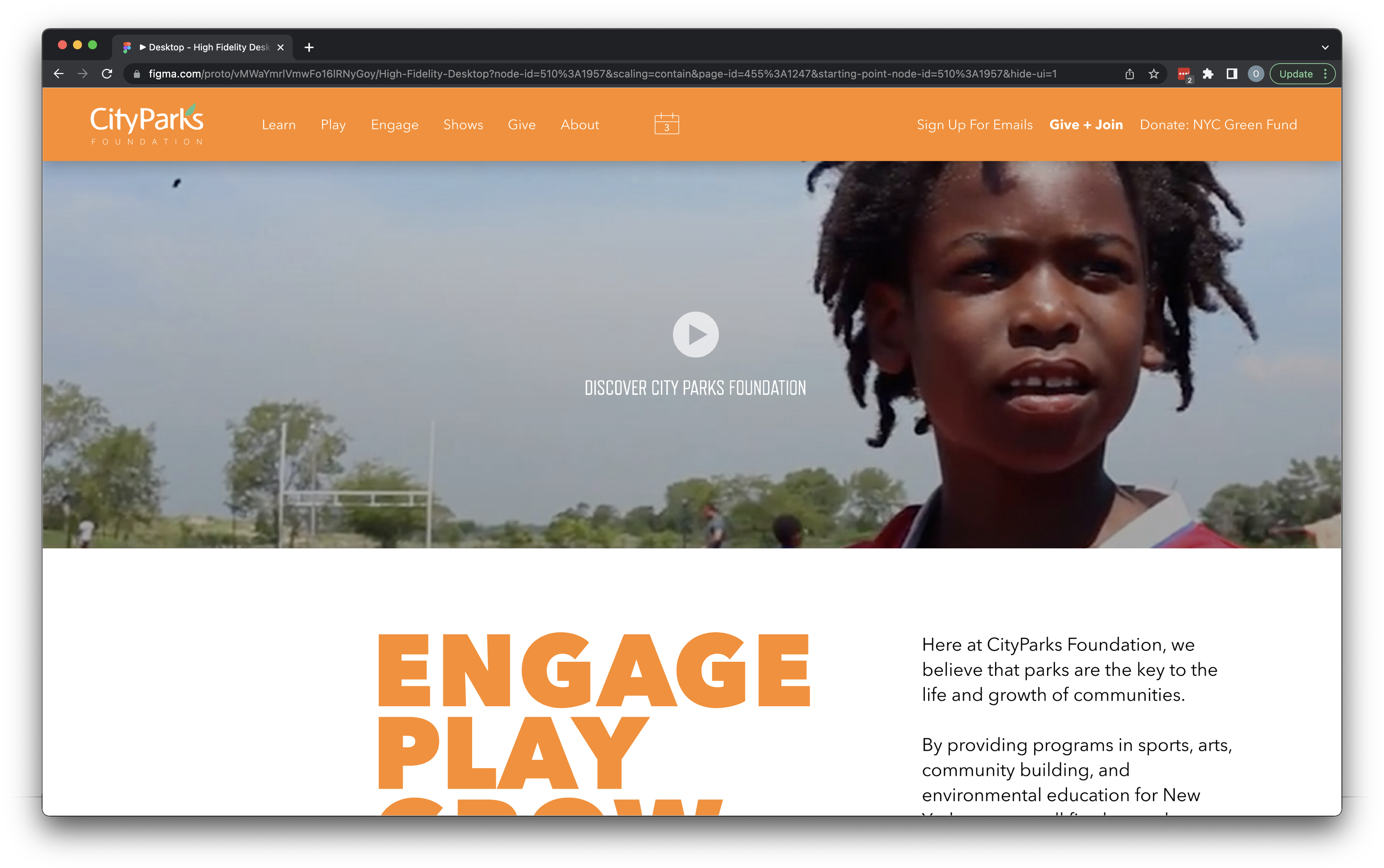
City Parks Foundation
Website Redesign
My Roles:
- Design Lead
- Research Methodology Designer
- Stakeholder Experience Researcher
My Team:
- Qiling Liu
- Evan Tao
Class:
- Information Architecture and Interaction Design
- March - May 2021
- Pratt Institute MS in Information Experience Design
Project Goal
To redesign the CityParks Foundation’s website to better serve the needs and wants of volunteers, a secondary user group of the site. (This is not meant to argue for the elevation of voluteers to a primary user group, just to better accomodate and design for them as they are vital members of the community).
Project Overview
Research
Stakeholder Research > Competitive Analysis > Site Evaluation
Research Goals:
To better understand the motivations behind acts of volunteerism, how potential volunteers decide on and between opportunities, and why they decided against certain opportunities.
To understand and identify how to best structure and design content for CityParks Foundation.
Findings
Perceivable impact was the largest factor that contributed to positive reflections towards past experiences and fed into motivation for future work.
Volunteerism necessarily lies in social domains. The desire to volunteer heavily hinges on connection to and outlook on society/community, and one’s ability to connect personal passions with others.
Major internal motivators of volunteering of our participants are self-development and expanding their networks.
Responses showed that desirability of opportunity was based on: safety of environment, care for volunteers, and the reputation of the host organization.
The analysis also showed that most volunteer experiences are found passively through social domains. Active searches were initiated secondarily and started in the social domain and bled into the digital if no (desirable) opportunities were found.
The presentation of volunteer opportunities also needs to be easily discoverable and easy to sign up for because active searching is tedious and easily discourages searching.
Stakeholder Research
In order to better understand the needs, motivations, and frustrations of our target audience, we conducted 8 semi-structured interviews and synthesized our findings by affinity diagraming. We then surveyed 20 people to test our findings and incorporate big and thick data.
Affinity Mapping

Persona
From our reinforced findings, we developed a set of three Personas.
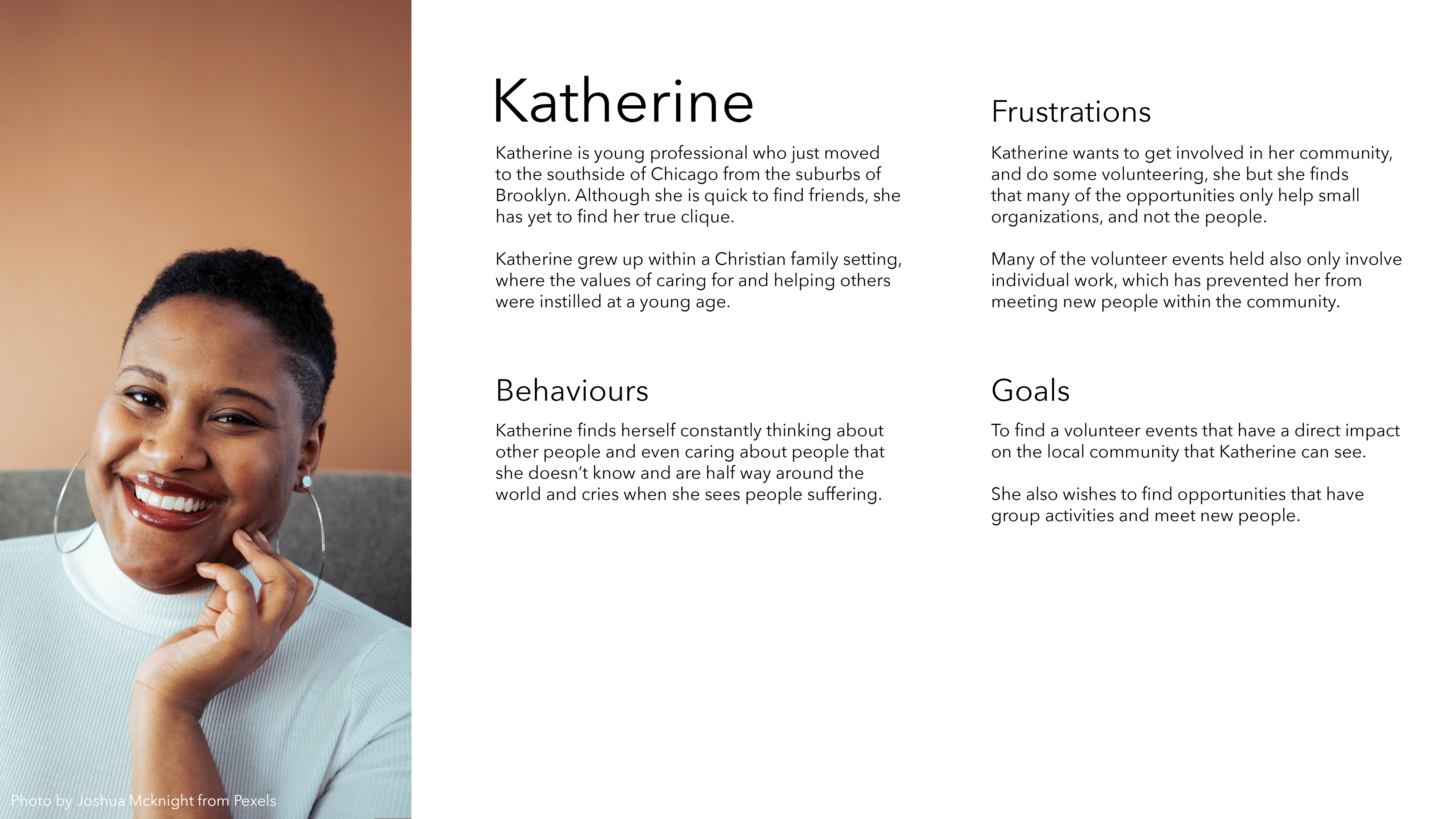
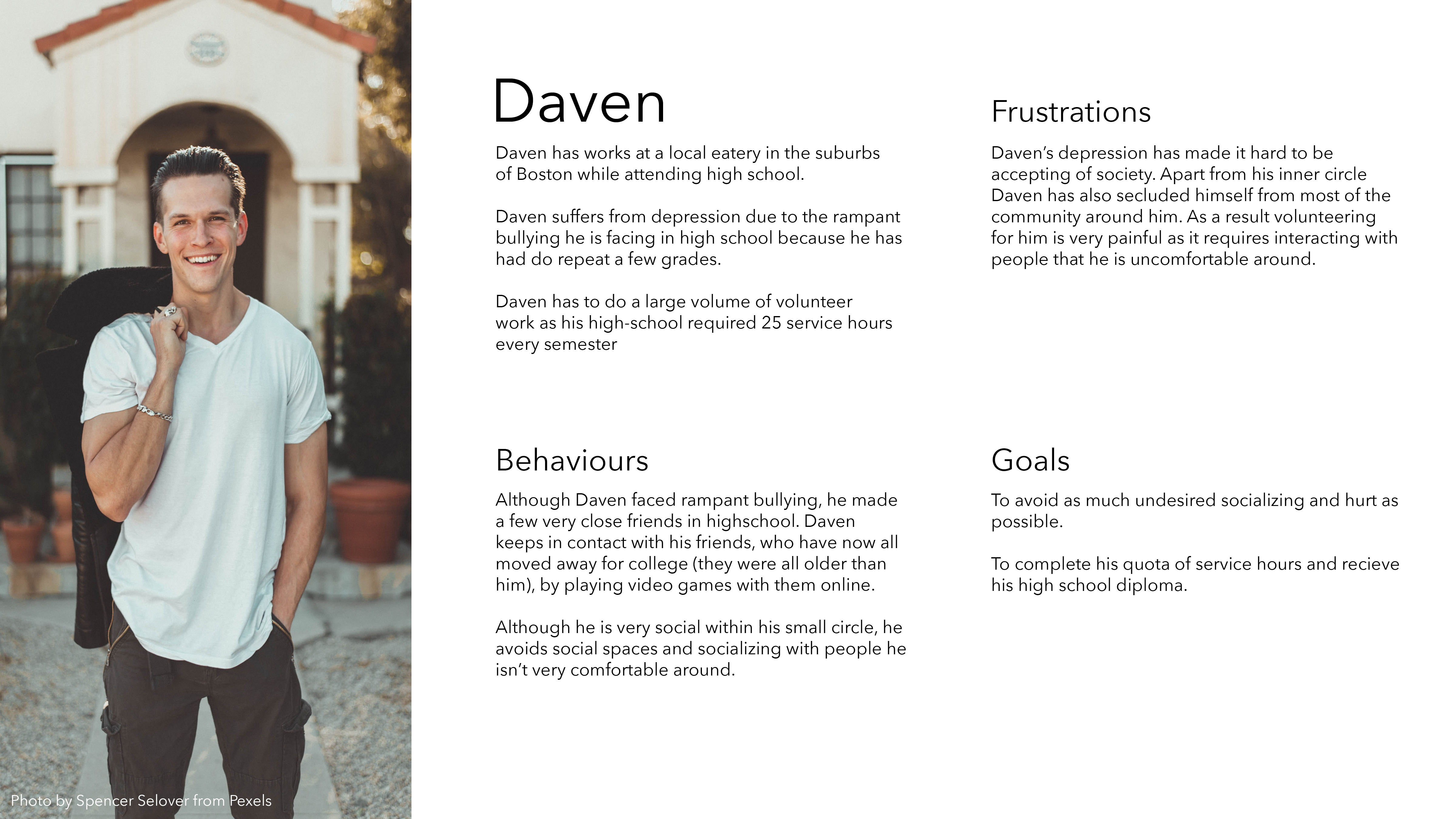

Competitive Analysis
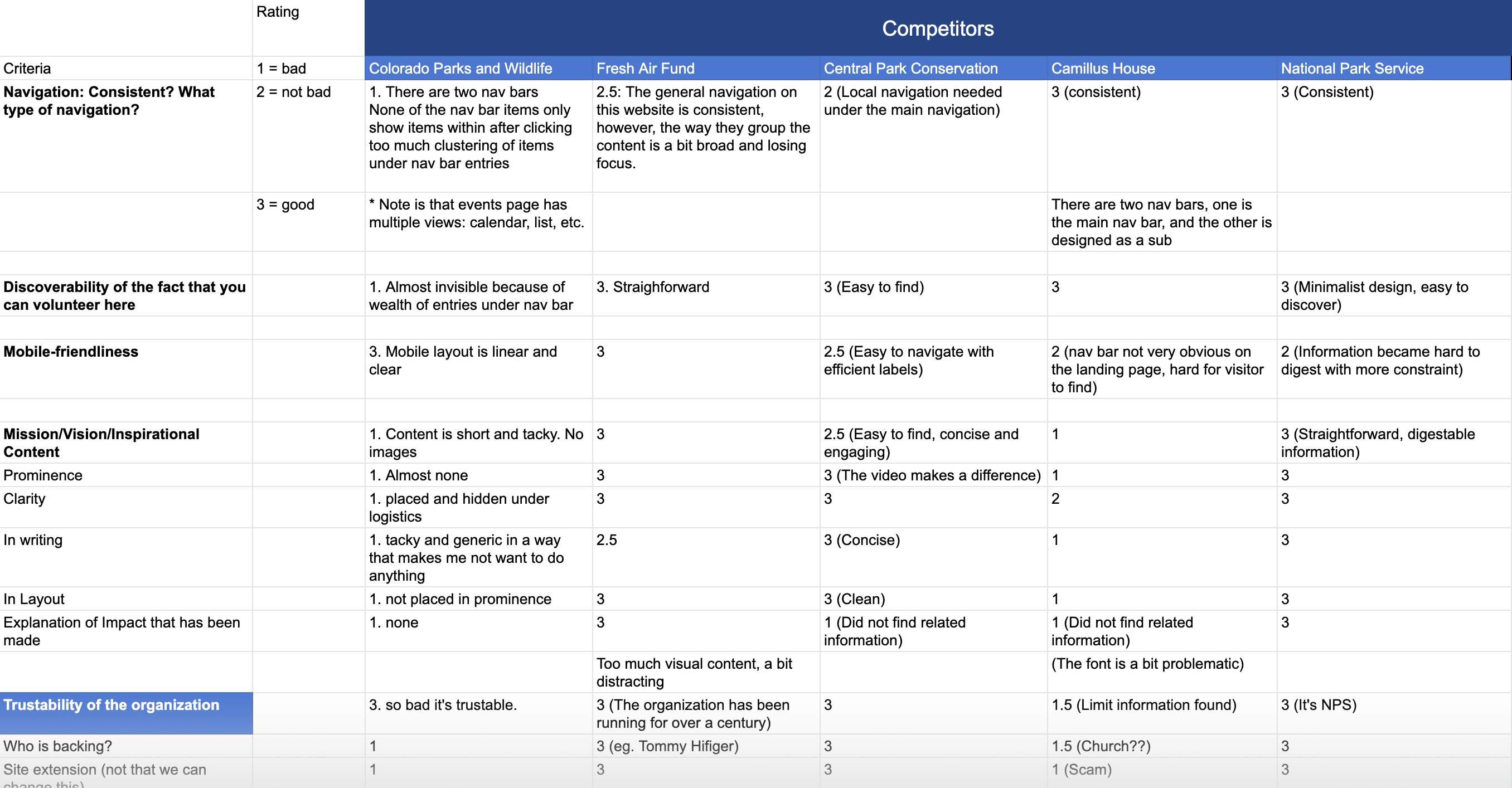
Evaluation of Concurrent Site
Card Sort
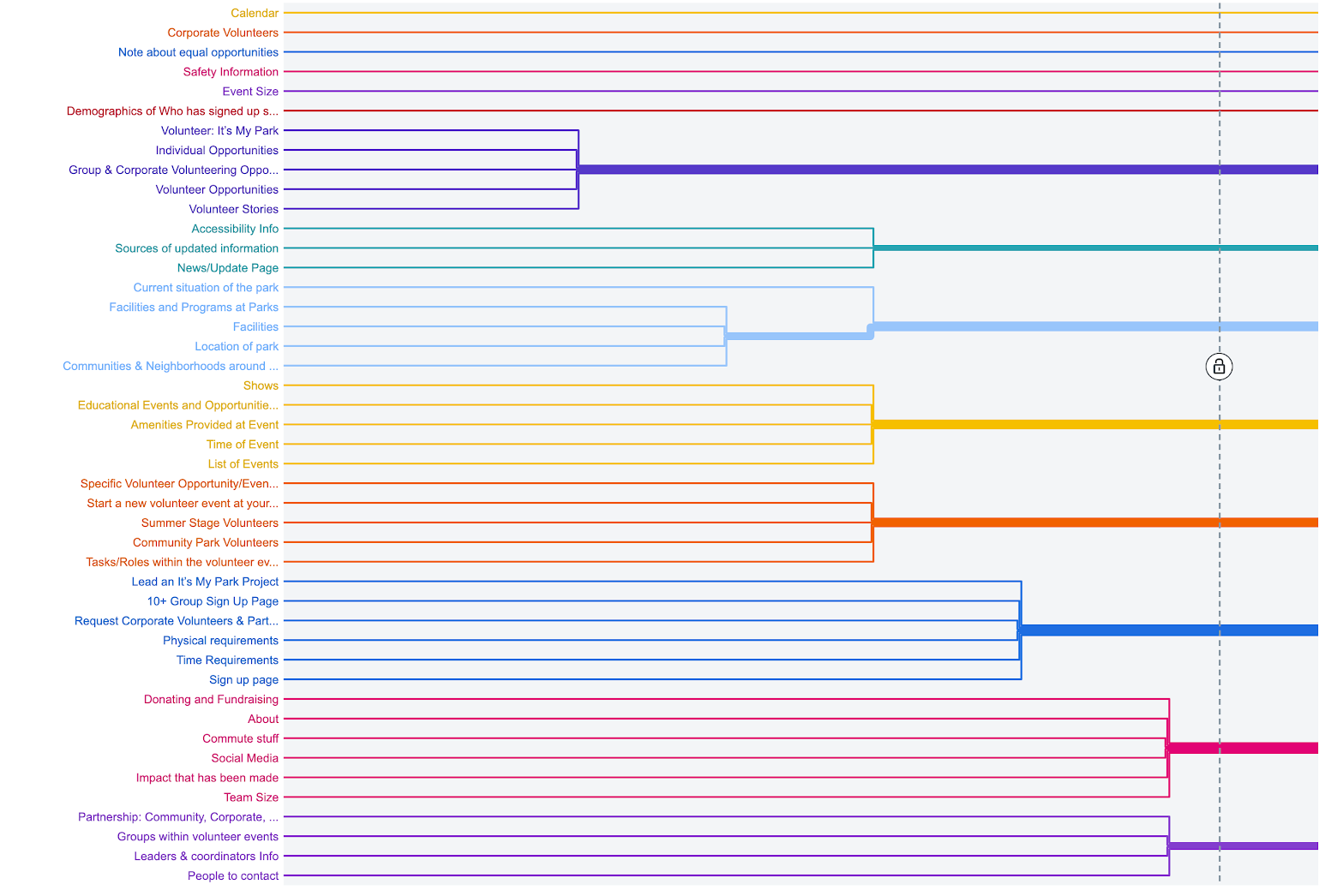
We analyzed and coded the content on the CPF website and devised a 45-card sort conducted by 7 participants in a semi-moderated setting, utilizing the think-aloud method. Based on how participants naturally organized the information, we were able theorize how to best design the information hierarchy and architecture.
From there, we developed an initial IA "prototype". While we had to adjust the architecture of the entire website due to the scattered state of volunteering related information, we focused on developing a new architectural segment to support the needs and alleviate the pain-points of our Personas and users.
We then created a tree-test using this architecture. This tree-test included the menu bar (signifying other nodes of content) and a deeper dive into the volunteer section. We tested this prototype with 9 participants through "think-a-loud" walkthroughs which allowed us to identify any issues or opportunities for improvement.
Tree Testing
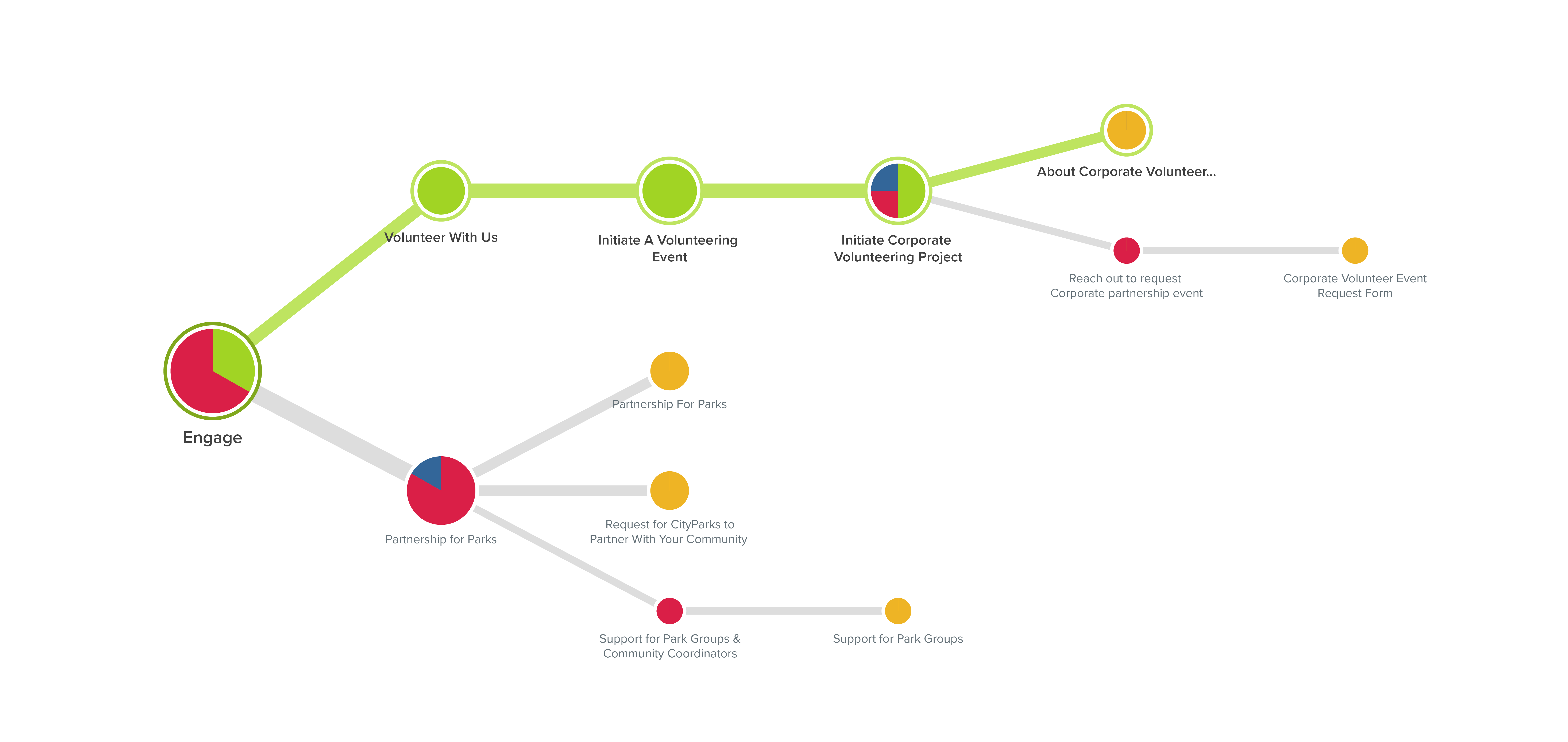
Our initial tree-test yielded no accurate responses leading us to theorized that this was due to inconsistency in granularity and with the Treejack platform as all participants experienced difficulties in understanding and navigating Treejack. We, therefore, created and conducted a second tree-test (with identical tasks on another 9 participants) that addressed platform issues and focused on the sections directly related to volunteering. This second tree test revealed:
- The over separation of information created extraneous navigation, which increased the difficulty of the task.
- “Corporate requests for cooperation and initiation of volunteer events” needs to be replicated in “Partnerships,” a sister-node to “Volunteering”–both of which stem from the “Engage” mother-node.
Tasks
- You have been wanting to get connected with your local community. Because of the prominence of park culture around your neighborhood, you know that volunteering at a nearby park would be a great way to connect with the community. So you are on the website of an organization that has partnered with over 300 parks in the city you are in. Browse the available volunteer events.
- You decided you are interested in an event held at the park down the road, where would you find information about the activities you might do during the event?
- It’s been two weeks since the event that you attended. Where would you find information about what impact you and your activities at the event have made?
- Your company has tasked you to lead a volunteer event at a local park, and You remember your personal experience volunteering with CityParks Foundation. Find more information about how companies can host events in partnership with CityParks.
Prototyping & Testing
Paper Prototype
To quickly test and evaluate our redesign for the City Parks Foundation, we created low- fidelity paper prototypes. We applied minimal visual elements to ensure that participants focus on the architecture and placement of information and labeling of content.
Six participants were asked to complete the following tasks while talking-aloud. Sessions were semi-moderated: moderators provided assistance when participants encountered areas of the prototypes that were faulty and/or underdeveloped.



Tasks
Task 1:
Browse the available section of the City Parks Foundation. Based on the information presented: What is the mission of City Parks Foundation? Who does the CityParks Foundation serve?
Goal:
To test the basic interaction between the Home page and the “Who We Are” page in the delivery of the overall mission and commitment of the CityParks Foundations.
Findings:
- Participants mainly drew from the “Who We Are” page to answer the questions asked.
- The Home page, functioned as a lens from which the content was viewed.
- The overall combination of content overfocused on the commitment to community, the internal goal of CPF, and the user group of volunteers.
- While volunteers is the user group that our team is focused on, volunteers are still the secondary to the “parents”, “educators”, and “community members” user groups.
- Possible desirability in consolidating content in the About section.
As a result of this finding, we have shifted to the approach of developing content through the lens of the needs of volunteers, but directed at the primary user groups. Inspiring and motivating rather than heavy-handed targeting.
Task 2:
You live in the greater Fulton area and noticed that there has been a lot of attention paid to the parks there recently. While browsing the site, you decided to find a volunteer opportunity to volunteer at a park near Fulton Street.
Goal:
To test the layout and architecture of the content in the process of registering for an opportunity.
Findings:
- Through both the longer and shorter nav paths, participants were able consistently navigate and register.
- Addition of redundancy of “initiate an event” at the bottom of “Volunteer Events Page”
- Revealed that architecture didn’t match the consolidations and expansions of content that we had planned (although participants didn’t realize).
Task 3:
You are the outreach manager at your company, and you want to host a volunteer event at the park nearby. Initiate the event through the CityParks Foundation.
Goal:
To test whether participants would go to “Initiate an Event” or “Corporate Partnerships” to initiate the corporate partnership event. We also wanted to test if participants would then go to initiate an event if “Corporate Partnerships” didn’t work.
Findings:
- Participants consistently went to Corporate Partnerships to initiate the event.
- Only a few participants went to “Initiate an Event” after Corporate Partnerships didn’t work.
- Corporate Partnerships page should include all the manners in which Corporations could partner with and help CPF.
Site Map
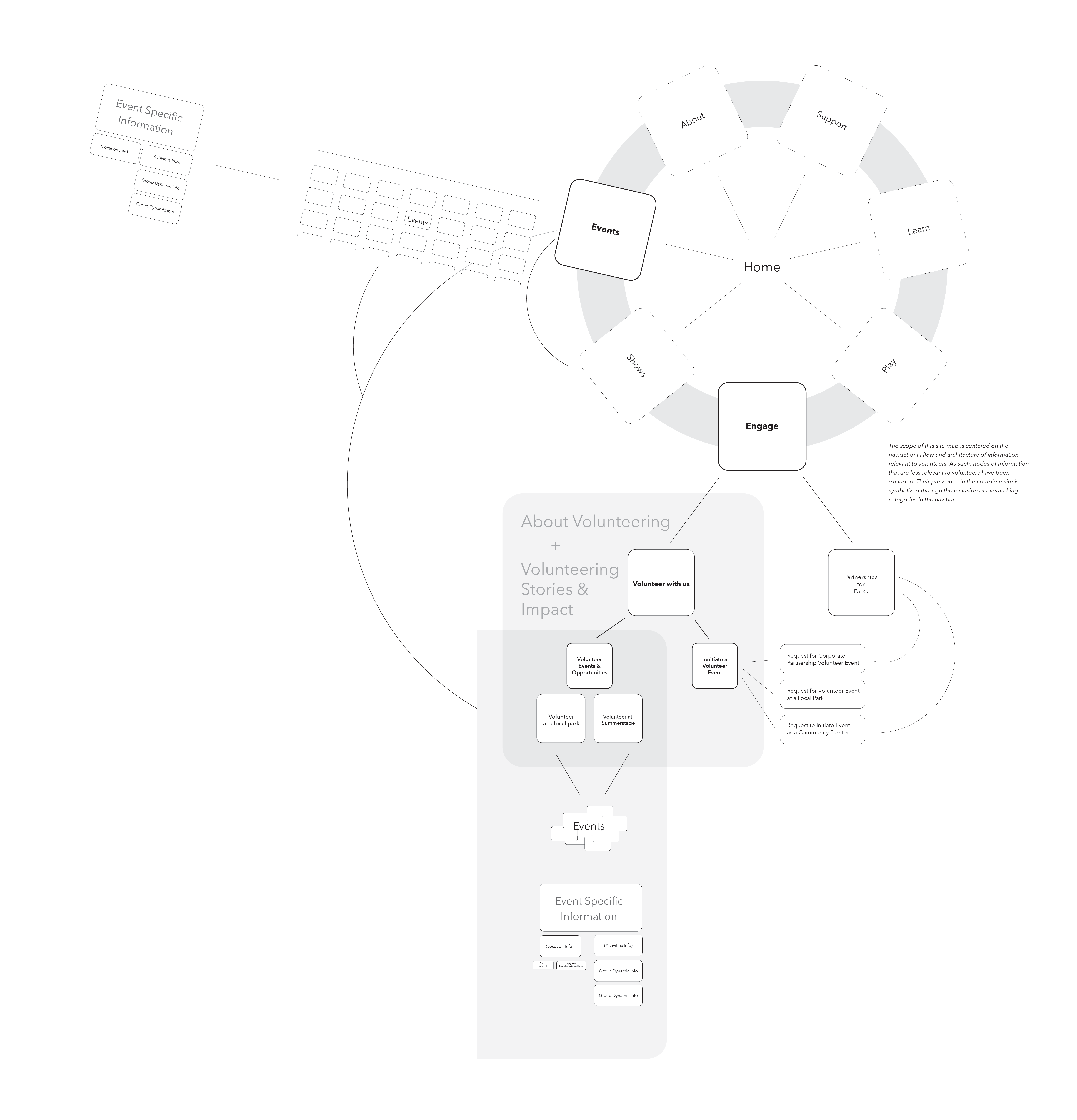
Medium Fidelity Prototypes

